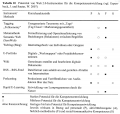E-Learning
E-Learning
- Folgende Zitate hängen zusammen:
- Klassisches E-Learning im Web 1.0 kennt in der Regel keine echten Dialoge, sondern rückgekoppelte Monologe. Es besteht eine deutliche Trennung von Experten (Lernprogrammentwickler) und Lernen. Es dient in erster Linie der Wissensvermittlung und -verarbeitung. [KUH08, S. 15]
- Kompetenzzentriertes E-Learning im Web 2.0 baut auf eine zweite Generation von WWW Services („Social Software“), die Menschen hilft, online zusammenzuarbeiten und Wissen zu teilen. Es setzt auf die Emanzipation der Lerner, die ihr Erfahrungswissen z.B. über Blogs und Wikis, aktiv einbringen und gemeinsam weiter entwickeln. [KUH08, S. 16]
- Nur ein E-Learning, das echte Entscheidungssituationen bieten, kognitive Dissonanzen setzen und emotionale Labilisierungen erzeugen kann, ermöglicht Kompetenzlernen. Und das ist mit klassischer E-Learning Software kaum, mit Web 2.0-Instrumenten sehr wohl möglich. Damit ist Social Software Kompetenzlernsoftware (Erpenbeck, J. und Sauter, W. 2007). [KUH08, S. 57]
- Im Zusammenhang mit Inklusionsmodell zu sehen.
- Vergleich von Lernen im Web 1.0 und Web 2.0:
-
Abb. aus [KUH08, S. 57]
-
Abb. aus [KUH08, S. 58]
- More and more educational scenarios or landscapes are developed utilizing Blogs, Wikis, Podcasts, and e-portfolios. Web 2.0 tools give learners much more control, through enabling learners easily to access, modify, or develop their own digital learning materials; and web 2.0 tools enable social learning networks that transcend the bounds of an individual class of students, thus blurring the distinction between formal and informal learning. [EHL10, Foreword, pg. v]
- Foreword written by Tony Bates.
- Nothing virtual has the impact of face-to-face communication, but it's neither cost effective nor physically possible to bring people together in the same room for every interaction. The structure and tools of what is called Web 2.0 [..] fit hand-in-glove with informal learning. [EHL10_02, pg. 52]
- Barrios and Carstensen (2004) have found that only 5% of the active faculty in German-speaking universities use learning technologies for their courses – a threshold for e-Learning integration which a recent OECD survey (2005) confirms at the international level. Zemksy and Massy (2004) have found no better results for the US higher education context. They have consequently dubbed e-Learning as a “thwarted innovation” in their report- And according to Latchem et al. (2007) the e-Learning integration in Japanese higher education advances at the leisurely speed of a tortoise. [EHL10_04, pg. 240]
- Faculty is nowadays facing new pedagogical challenges; they have to design learning environments, which respond to the changing needs of technology-savvy students; and they have to integrate ICT [Anm. Information and communication technologies] into their courses to extend the flexibility of educational services in universities. But does faculty have the competences to respond to these challenges?A number of studies (...) state that an inadequate level of e-Competence of the majority of faculty members is one reason for the slow adoption of e-Learning in higher education. Academic teachers have to enhance existing competences and acquire new competences that enable them to know and to judge why, when, and how to use ICT [Anm. Information and communication technologies] in education. [EHL10_04, pg. 240-241]
Web 2.0 und Kompetenzentwicklungsprozesse
Der folgende Abschnitt ist mit dem Inklusionsmodell verknüpft. Die Inhalte bauen auf diesem Modell auf bzw. nehmen dazu Bezug.
Dazu bitte auch den Abschnitt Kompetenzentwicklung auf der Seite Lernen beachten.
Dazu bitte auch den Abschnitt Kompetenzentwicklung auf der Seite Lernen beachten.
- Abb. aus [KUH08, S. 59], Potenziale von Web 2.0 Instrumenten:
- The question of the emotional labilization is, in my point of view, also the leading question when designing e-Learning that furthers competences.
Regarding the new instruments, methods, and processes of Web 2.0, it is possible to ask which potential they have to spark further and accompany true changes and development of competences when exhausting all possibilities. (...)
The following Table 22.1 briefly explains the instruments and methods and lists the optimal potential for labilization (...), as relating to personal (P), activity-related (A), subject-specific-methodological (S), and socio-communicative (SC) competences. A high degree of labilization concerning P means, for example, that this instrument can be used very effectively for the development of personal competence in e-Learning (Erpenbeck and Sauter 2007). [EHL10_01, pg. 309]
-
aus [EHL10_01, pg. 310]
-
aus [EHL10_01, pg. 311]
-
aus [EHL10_01, pg. 312]
- Wikis eignen sich gut für die Förderung der Kompetenzentwicklung, da die Lerner auch wertbeladenes Wissen transportieren können. Sie können damit in der Kommunikation mit ihrem Netzwerk eigene Emotionen und Motivationen entwickeln. Wikis eignen sich aufgrund ihrer einfachen Handhabung aber auch zur Initiierung von kreativen Prozessen mittels Brainstorming. [KUH08, S. 152]
- Blogs spiegeln generell die Erfahrungen der Lerner im Rahmen ihrer Lernprozesse wider. Sie sind in hohem Maße geeignet, Kompetenzentwicklung in Netzen zu fördern. [KUH08, S. 154-155]
- Weblogs fördern insbesondere die Entwicklung der personalen Kompetenzen, da sich die Lerner reflexiv mit sich selbst auseinander setzen müssen und dabei Werthaltungen entwickeln. (...) Aber auch die fachlich-methodischen Kompetenzen sowie die aktivitätsbezogene Kompetenz werden mit Hilfe von Blogs herausgebildet, denn der Weblog-Autor muss seine Artikel aus eigenem Antrieb methodisch kreativ gestalten und sein Vorgehen zielgerichtet strukturieren. [KUH08, S. 157]
- Podcasts besitzen eine hochemotional-motivationale Eindringlichkeit, so dass sie besonders in den personalen sowie sozial-kommunikativen Kompetenzbereichen wirksam sind. Bei den aktivitätsbezogenen Kompetenzen liegt ein mittleres Entwicklungspotenzial vor. [KUH08, S. 158]
- Social Bookmarking eignet sich gut, um Quellen für den Lernprozess zu finden, zu bewerten und in den eigenen Strukturen der Lerner einzuordnen. Dadurch wird vor allem die fachlich-methodische, aber auch die aktivitätsbezogene Kompetenz gefördert. [KUH08, S. 159]
Blended-Learning
- In Blended-Learning-Konzeptionen erfolgen die Wissensvermittlung und die -verarbeitung überwiegend im E-Bereich, während der Wissenstransfer in praxisorientierte Problemstellungen in Workshops bzw. am Arbeitsplatz oder in Projekten geschieht. [KUH08, S. 15]
![Abb. aus [KUH08, S. 57]](/kouw/images/thumb/7/71/Kuh08_57.png/120px-Kuh08_57.png)
![Abb. aus [KUH08, S. 58]](/kouw/images/thumb/5/5a/Kuh08_58.png/120px-Kuh08_58.png)

![aus [EHL10_01, pg. 310]](/kouw/images/thumb/c/c5/Ehl10_01_s310.png/76px-Ehl10_01_s310.png)
![aus [EHL10_01, pg. 311]](/kouw/images/thumb/0/00/Ehl10_01_s311.png/74px-Ehl10_01_s311.png)
![aus [EHL10_01, pg. 312]](/kouw/images/thumb/6/68/Ehl10_01_s312.png/120px-Ehl10_01_s312.png)